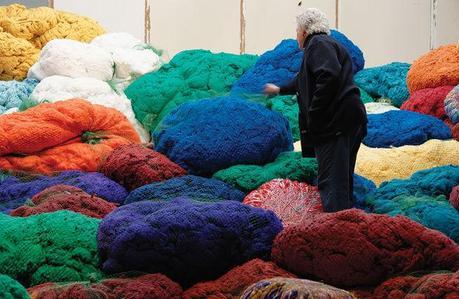
The American fiber artist Sheila Hicks began her career over 50 years ago under the tutelage of Josef and Anni Albers at Yale. She then gathered material influences in South America before refining her exuberant, tactile approach to color in Paris, where she’s lived and worked since 1964.
Don’t expect the artist to slack off anytime soon, however, and don’t just call her a weaver. Hicks stitches, she spools, she braids, she unravels, and she binds, until she arrives as the perfect texture—in her words, the “life blood” of a project. Such an approach has made her an outsider in traditional art circles, but celebrated among the 20th century’s modern gallerists, collectors, architects, and designers.
Among several major exhibitions of her work in 2014—including a site-specific installation for the Whitney Biennial in Marcel Breuer’s Madison Avenue landmark, a temporary installation during Art Basel, and an addition to her first corporate commission at the Ford Foundation headquarters—Hicks put together a yearlong display at the Palais de Tokyo in Paris. The constantly-evolving Baoli—whose title references the immense, stair-stepped wells dug into the ground throughout western India—comprises 1,500 pounds of pigmented Sunbrella thread, bound together with acrylic net. The installation is visually distinctive, but, Hicks says, “The color I use is not conceptual or abstract; it’s color that has texture. There’s a big difference.”
Up next for the formidable Hicks is a new line of paint, in development with the French gallery Demisch Danant, that draws on her decades of experience playing with color. The twist? It will incorporate texture, which Hicks likens to “turning up the volume. It’s like working with color in stereo.”
